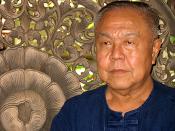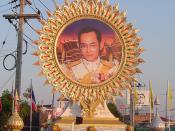The power of the Thai king, His Majesty Bhumibol Adulyadej (Rama IX), is evident as soon as a visitor sets foot in the country. The widespread use of the iconic image of the king makes the extent of the power over the public consciousness clear; his face adorns the currency, and his portrait hangs in public places and private homes alike. Though Thailand has not been an absolute monarchy since 1932, the king wields great power over the populace and holds political sway through the people's response to his personal authority. So great is the public's respect for his power that one of Thailand's most outspoken intellectuals, Sulak Sivaraksa, was arrested in the early 1980s "for a passing reference to the kings fondness for boating. (Sulak referred to His Majesty as 'the skipper') and again in 1991 when he referred to the royal family as 'ordinary people'."(1)
The power of the king and the consistency of the public's affection for him during his fifty-five year reign stand in sharp contrast to continued upheaval that plagues Thailand's government.
Between 1932 and 1973, the country has seen 19 unconstitutional attempts to overthrow the government, of which 13 were successful. As Clark Neher writes, "Political succession in Thailand, unguided by constant norms, is best viewed as an unpatterned ad hoc event dependent on changing allegiances and power advantages held by various elite groups." (2) In the absence of traditional patterns of governmental succession, the weight of the King's opinion, and his power as a stabilizing and legitimizing force cannot be overstated.
Some of the king's political power can be traced to the revival of many of the symbolic aspects of the kingship by Sarit following his 1957 coup. By claiming to have already informed the king of his actions, and by portraying...


